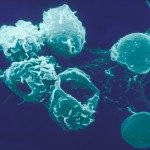Link to Pubmed [PMID] – 17013389
Nat. Immunol. 2006 Nov;7(11):1217-24
Natural killer (NK) cell development is thought to occur in the bone marrow. Here we identify the transcription factor GATA-3 and CD127 (IL-7R alpha) as molecular markers of a pathway of mouse NK cell development that originates in the thymus. Thymus-derived CD127+ NK cells repopulated peripheral lymphoid organs, and their homeostasis was strictly dependent on GATA-3 and interleukin 7. The CD127+ NK cells had a distinct phenotype (CD11b(lo) CD16- CD69(hi) Ly49(lo)) and unusual functional attributes, including reduced cytotoxicity but considerable cytokine production. Those characteristics are reminiscent of human CD56(hi) CD16- NK cells, which we found expressed CD127 and had more GATA-3 expression than human CD56+ CD16+ NK cells. We propose that bone marrow and thymic NK cell pathways generate distinct mouse NK cells with properties similar to those of the two human CD56 NK cell subsets.


